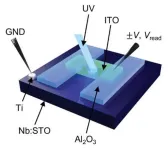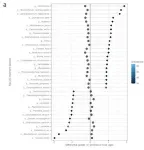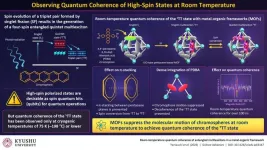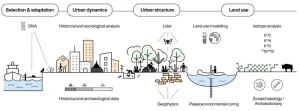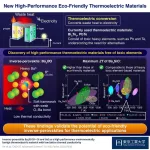(Press-News.org) Every day, a significant amount of data related to weather, traffic, and social media undergo real-time processing. In traditional cloud computing, this processing occurs on the cloud, raising concerns about issues such as leaks, communication delays, slow speeds, and higher power consumption. Against this backdrop, “edge computing” presents a promising alternative solution. Located near users, it aims to distribute computations, thereby reducing the load and speeding up data processing. Specifically, edge AI, which involves AI processing at the edge, is expected to find applications in, for example, self-driving cars and machine anomaly prediction in factories.
However, for effective edge computing, efficient and computationally cost-effective technology is needed. One promising option is reservoir computing, a computational method designed for processing signals that are recorded over time. It can transform these signals into complex patterns using reservoirs that respond nonlinearly to them. In particular, physical reservoirs, which use the dynamics of physical systems, are both computationally cost-effective and efficient. However, their ability to process signals in real time is limited by the natural relaxation time of the physical system. This limits real-time processing and requires adjustments for best learning performance.
Recently, Professor Kentaro Kinoshita, a member of the Faculty of Advanced Engineering and the Department of Applied Physics at the Tokyo University of Science (TUS), and Mr. Yutaro Yamazaki from the Graduate School of Science and the same department at TUS developed an optical device with features that support physical reservoir computing and allow real-time signal processing across a broad range of timescales within a single device. Their findings were published in Advanced Science on 20 November 2023.
Speaking of their motivation for the study, Prof. Kinoshita explains: "The devices developed in this research will enable a single device to process time-series signals with various timescales generated in our living environment in real time. In particular, we hope to realize an AI device to utilize in the edge domain."
In their study, the duo created a special device using Sn-doped In2O3 and Nb-doped SrTiO3 (denoted as ITO/Nb:STO), which responds to both electrical and optical signals. They tested the electrical features of the device to confirm that it functions as a memristor (a memory device that can change its electrical resistance). The team also explored the influence of ultraviolet light on ITO/Nb:STO by varying the voltage and observing changes in the current. The results suggested that this device can modify the relaxation time of the photo-induced current according to the voltage, making it a potential candidate for a physical reservoir.
Furthermore, the team tested the effectiveness of ITO/Nb:STO as a physical reservoir by using it for classifying handwritten digit images in the MNIST (Modified National Institute of Standards and Technology) dataset. To their delight, the device achieved a classification accuracy of up to 90.2%. Additionally, to understand the role of the physical reservoir, the team ran experiments without it, which resulted in a relatively lower classification accuracy of 85.1%. These findings show that the ITO/Nb:STO junction device improves classification accuracy while keeping computational costs lower, proving its value as a physical reservoir.
“In the past, our research group has focused on research and development of materials applicable to physical reservoir computing. Accordingly, we fabricated these devices with the aim to realize a physical reservoir in which the relaxation time of photo-induced current can be arbitrarily controlled by voltage,” says Prof. Kinoshita.
In summary, this study presents a novel memristor device capable of adjusting its response timescale through voltage variation, exhibiting enhanced learning capabilities, which makes it promising for applications at the edge as an AI device for edge computing. This, in turn, could pave the way for single devices that can effectively handle signals of varied durations found in real-world environments.
***
Reference
DOI: https://doi.org/10.1002/advs.202304804
About The Tokyo University of Science
Tokyo University of Science (TUS) is a well-known and respected university, and the largest science-specialized private research university in Japan, with four campuses in central Tokyo and its suburbs and in Hokkaido. Established in 1881, the university has continually contributed to Japan's development in science through inculcating the love for science in researchers, technicians, and educators.
With a mission of “Creating science and technology for the harmonious development of nature, human beings, and society," TUS has undertaken a wide range of research from basic to applied science. TUS has embraced a multidisciplinary approach to research and undertaken intensive study in some of today's most vital fields. TUS is a meritocracy where the best in science is recognized and nurtured. It is the only private university in Japan that has produced a Nobel Prize winner and the only private university in Asia to produce Nobel Prize winners within the natural sciences field.
Website: https://www.tus.ac.jp/en/mediarelations/
About Professor Kentaro Kinoshita from Tokyo University of Science
Professor Kentaro Kinoshita is a member of the Faculty of Advanced Engineering and the Department of Applied Physics at the Tokyo University of Science. He earned a Ph.D. degree from the University of Tokyo. With a focus on functional materials and memory devices, he has over 110 publications with over 2,800 citations. He has also won numerous awards like Kloxia's Excellent Research Award (2020) and Tottori University's Scientific Research Achievement Award (2016) and served on committees like the International Conference on Memristive Materials, Devices & Systems (MEMRISYS) and the Solid State Devices and Materials (SSDM) conference.
Funding information
This work was supported by JSPS KAKENHI Grant No. 19K04476.
END
Fukuoka, Japan—In a study published in Science Advances, a group of researchers led by Associate Professor Nobuhiro Yanai from Kyushu University's Faculty of Engineering, in collaboration with Associate Professor Kiyoshi Miyata from Kyushu University and Professor Yasuhiro Kobori of Kobe University, reports that they have achieved quantum coherence at room temperature: the ability of a quantum system to maintain a well-defined state over time without getting affected by surrounding disturbances
This breakthrough was made possible by embedding a chromophore, ...
PULLMAN, Wash. -- Researchers have taken the first steps toward finding liquid solvents that may someday help extract critical building materials from lunar and Martian-rock dust, an important piece in making long-term space travel possible.
Using machine learning and computational modeling, Washington State University researchers have found about half a dozen good candidates for solvents that can extract materials on the moon and Mars usable in 3D printing. The work, reported in the Journal of Physical Chemistry B, is led by Soumik Banerjee, associate professor in WSU’s School of Mechanical ...
Where we live and work, our age, and the conditions we grew up in can influence our health and lead to disparities, but these factors can be difficult for clinicians and researchers to capture and address. A new study by investigators from Mass General Brigham demonstrates that large language models (LLMs), a type of generative artificial intelligence (AI), can be trained to automatically extract information on social determinants of health (SDoH) from clinicians’ notes which could augment efforts to identify patients who may benefit from ...
Researchers at the University of California San Diego have developed a neural implant that provides information about activity deep inside the brain while sitting on its surface. The implant is made up of a thin, transparent and flexible polymer strip that is packed with a dense array of graphene electrodes. The technology, tested in transgenic mice, brings the researchers a step closer to building a minimally invasive brain-computer interface (BCI) that provides high-resolution data about deep neural activity by using recordings from the brain surface.
The work was published on Jan. 11 in Nature Nanotechnology.
“We are expanding the spatial ...
Cities play a key role in climate change and biodiversity and are one of the most recognizable features of the Anthropocene. They also accelerate innovation and shape social networks, while perpetuating and intensifying inequalities. Today over half of all humanity lives in cities, a threshold which will rise to nearly 70% by the mid-21st century. Yet despite their importance for the Anthropocene, cities are not a recent phenomenon.
In a new study, an interdisciplinary team of authors from the Max Planck Institute of Geoanthropology ...
Francis Crick Institute press release
Under strict embargo: 10:00hrs GMT 11 January 2024
Peer reviewed
Observational study
People
First prehistoric person with Turner syndrome identified from the Iron Age
Earliest known person with Jacob’s syndrome identified from Early Medieval Period
Individuals with Klinefelter syndrome identified across a range of time periods
New technique developed to measure number of chromosomes in ancient genomes more precisely
Researchers at the Francis Crick Institute, working with University of Oxford, University of York ...
Researchers have linked a decade-long decline in the blood lead levels of American Indian adults to long-term cardiovascular health benefits, including reduced blood pressure levels and a reduction in a marker associated with hypertrophic cardiomyopathy and heart failure. The research team, supported by the National Institutes of Health, found that adults who had the greatest reductions in blood lead levels saw their systolic blood pressure fall by about 7 mm Hg, an amount comparable to the effects of blood pressure-lowering medication. Lead exposure is known to harm the health of children by damaging the brain and nervous system and slowing growth and development. It has also been associated ...
Through the Strong Heart Family Study, National Institutes of Health-supported researchers found that small declines in blood lead levelswere associated with long-term cardiovascular health improvements in American Indian adults. Participants who had the greatest reductions in blood lead levels saw their systolic blood pressure fall by about 7 mm Hg, an amount comparable to the effects of blood pressure-lowering medication.
The findings as reported from researchers at Columbia ...
A multi-national team of scientists (China, USA, New Zealand, Italy, and France) analyze the temperature of the Earth annually. These scientists have found a fever that increases every year. For the past decade, each year has been hotter than the prior year in the ocean. And there are other changes in the ocean that also matter.
The ocean is an important part of the Earth's climate system – it covers 70% of the planet and absorbs about 90% of the heat from global warming. The ocean helps control the atmosphere – a warmer ocean leads to a warmer and moister atmosphere with wilder weather. The ocean also controls ...
In a new study, environmentally benign inverse-perovskites with high energy conversion efficiency have been reported by Tokyo Tech scientists with potential for practical application as thermoelectric materials (TEMs). Addressing the limitations typically faced with TEMs, such as insufficient energy conversion efficiency and environmental toxicity due to heavy elements, the new TEMs provide a suitable alternative to TEMs based on toxic elements with better thermoelectric properties than conventional eco-friendly TEMs.
Thermoelectric materials (TEMs) capable of converting thermal energy to electrical energy and vice versa have become an essential part of our world, which needs ...
